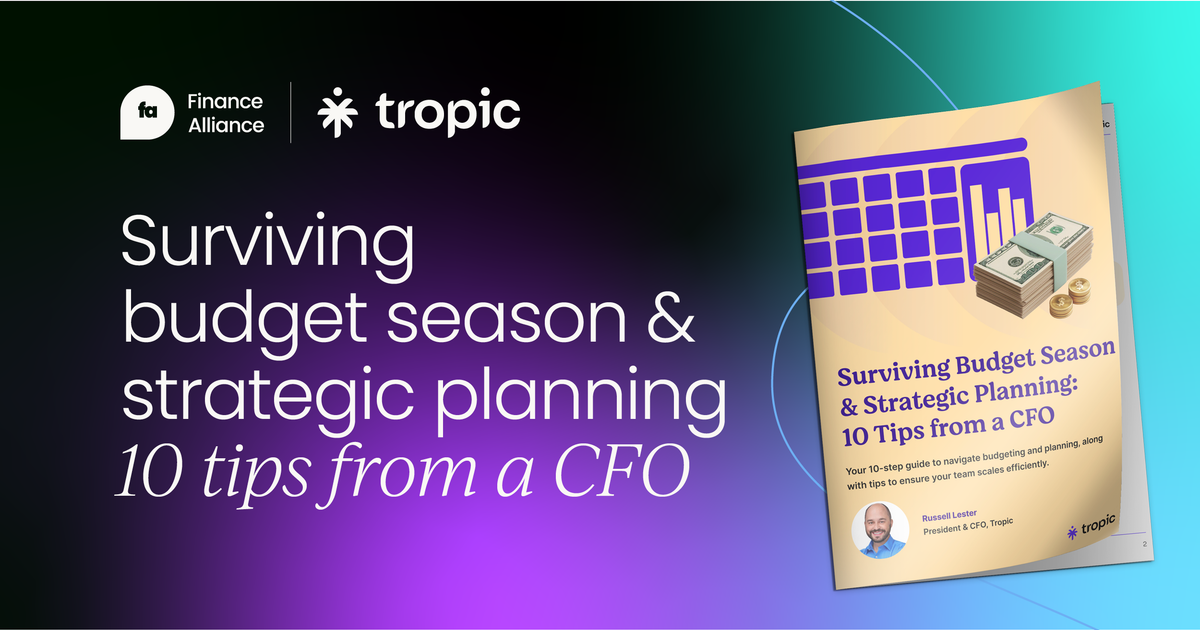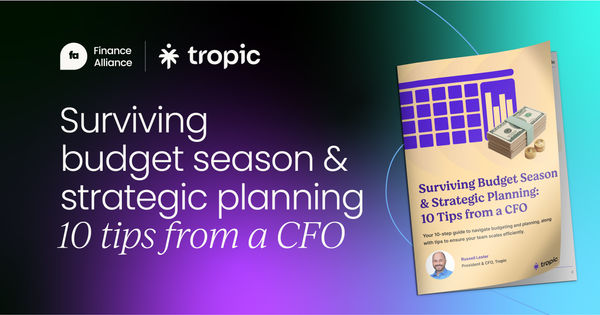Budget season. The time when optimism meets Excel, when strategic vision drowns in endless “what if” models, and when CFOs across every industry feel the familiar mix of exhaustion, anxiety, and disbelief that (somehow) it’s that time again.
For most organizations, budget season is chaos disguised as planning. Forecasts shift daily, targets contradict each other, departments scramble for approvals while the market outside moves faster than your models can refresh.
And then, by the time the fiscal year begins, that 60-page “strategic plan” you spent months building becomes obsolete before it even launches.
Russell Lester, President and CFO of Tropic, has lived through it all. In his new guide, Surviving Budget Season & Strategic Planning: 10 Tips from a CFO, he distills two decades of hard-won experience into one reality check for modern finance leaders.
“How a company spends money is directly tied to where it’s placing its bets. Not all bets pay off. Some should no longer be made. Markets change, priorities shift. That doesn't mean the plan was wrong, it means we're not operating in a static universe.”
This is a dangerous truth for leaders still treating budgeting as a compliance exercise rather than a competitive weapon.
Below are three of Lester’s ten CFO-approved insights, the kind that separate teams who barely survive budget season from those who dominate it.
You’ll have to download the (free) guide to get the rest of his tips.

1. Budget season starts in the mirror, not in the spreadsheet
Most finance teams start planning in the wrong place: inside last year’s numbers. They dust off a stale Excel template, plug in “+10% growth,” and call it a baseline. But that shortcut is what kills agility.
Before you even touch a model, Lester insists on conducting a “strategy retrospective.”
That means examining the bets your company made last year:
- Which ones paid off?
- Which ones fizzled?
- Which ones looked smart at the time but ultimately distracted from the mission?
This backward glance becomes your strategic MRI. It exposes blind spots and helps you separate what’s actually driving growth from what’s just keeping you busy.
From there, Lester recommends recalibrating your entire financial narrative. Start by revalidating your 1–3–5-year plan, reevaluating your total addressable market, and honestly confronting the competitive realities reshaping your industry.
In 2026, that means asking hard questions about AI disruption, inflation, and global supply instability. Because pretending your model exists in a vacuum is the surest way to make it irrelevant.
Only once your strategic direction is grounded in reality can your numbers begin to mean anything.
“Companies that thrive treat strategic planning as a year-round discipline, not a seasonal scramble. This is where balance, insight, data-centricity, judgment, and the ability to unify and align departments will become our new secret toolbox to weed out the noise.”
2. Build a budget that balances ambition and sanity
Another insight hits where it hurts: target setting. This is where most organizations either ignite or implode.
Executives want growth. Investors want returns. Employees want clarity. And the finance team? They’re the referee, forced to translate dreams into numbers.
Lester argues that the most dangerous targets are the ones set by instinct. They’re too optimistic to be believable or too safe to be inspiring. Either way, they erode confidence before execution even begins.
The solution lies in balance and data.
He suggests the key metrics every CFO should master:
- Rule of 40: A test of balance between growth and profitability.
- Revenue per employee: The ultimate litmus for operational efficiency.
- Unit economics: The heartbeat of sustainable growth.
But the real insight is in the mindset. According to Lester, target setting isn’t just a numbers game, it’s a trust game. When you present a plan to your board or team, they’re not judging your Excel formulas. They’re judging your judgment.
A credible CFO knows how to thread the needle between aspiration and realism: ambitious enough to motivate, grounded enough to survive scrutiny.
That credibility is currency. Lose it, and every future forecast becomes an uphill battle for belief. And if your organization doesn’t yet have the systems to anchor forecasts in data rather than gut feelings, that’s your red flag.
Because no matter how confident your presentation looks, if your budget is built on guesswork, you’re not planning, you’re gambling.
3. The hidden leaks that quietly destroy your growth
Every company has them, the silent killers of efficiency that CFOs don’t discover until it’s too late.
Duplicated tools, overlapping software, contracts on auto-renew that no one remembered approving.
Lester calls these leakages, the invisible losses that quietly drain your bottom line while everyone’s too busy chasing top-line growth.
Great finance teams develop a “levers and leakages” framework, a repeatable process for identifying not just where waste exists, but where opportunity hides.
- Levers are accelerators: strategic actions that multiply results when pulled at the right time.
- Leakages are inefficiencies: recurring costs, redundant vendors, or misaligned investments that sabotage ROI.
The key is to make this process permanent, not reactive. Most companies only look for leakages at the end of a quarter, when the damage is already done. The best CFOs treat it as a living discipline, a financial flywheel that never stops spinning.
He challenges finance leaders to ask uncomfortable questions:
- Why are we still paying for tools that don’t ladder up to core priorities?
- Which processes add complexity instead of clarity?
- What investments look strategic on paper but don’t move the needle in practice?
Why budget season fails most companies
Lester’s guide doesn’t romanticize budget season. It exposes it. He paints a brutally honest picture of why so many well-intentioned plans fail before they’re even finalized:
- Budgets built on outdated assumptions.
- Teams operating on emotion, not data.
- Spend disconnected from growth priorities.
- Finance teams stuck in firefighting mode instead of leading strategically.
And here’s the uncomfortable truth: every dollar you misallocate today is a dollar that could have fueled your next strategic move.
Every redundant tool, every bloated department, every vanity project that survives the cut, it all compounds. By Q3, you’re not just missing targets but actually hemorrhaging confidence.
And in an era where markets shift overnight and investors expect instant accountability, you can’t afford to be surprised by your own budget.
Download the full guide: 10 tips from a CFO who’s been there
These three insights barely scratch the surface. Russell Lester’s Surviving Budget Season & Strategic Planning goes deeper into the frameworks, decision models, and hidden CFO playbooks that transform how leaders approach planning entirely.
If your next budget could make or break your year, this guide might be the most important thing you read before you finalize it.
👉 Download the full guide now and learn how to master the CFO strategies that will keep your business grounded, data-led, and resilient, no matter what 2026 throws your way.



 Follow us on LinkedIn
Follow us on LinkedIn




